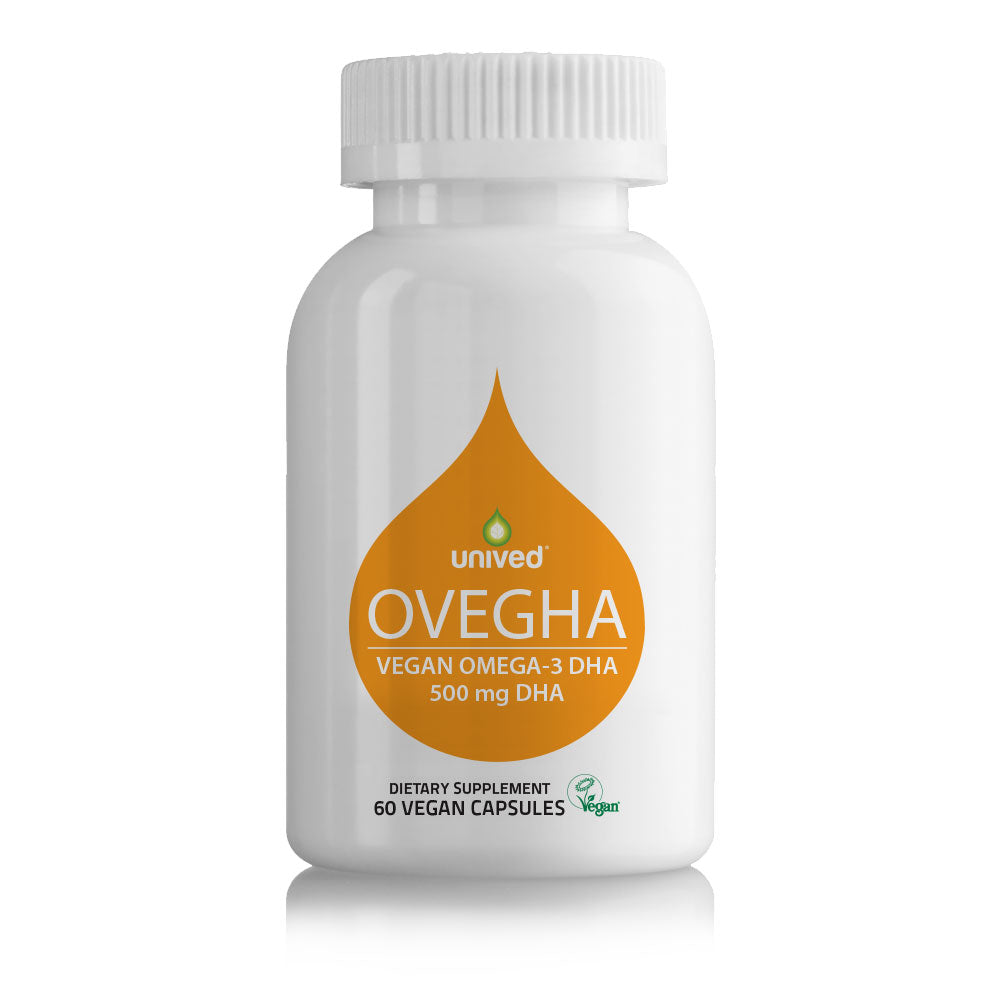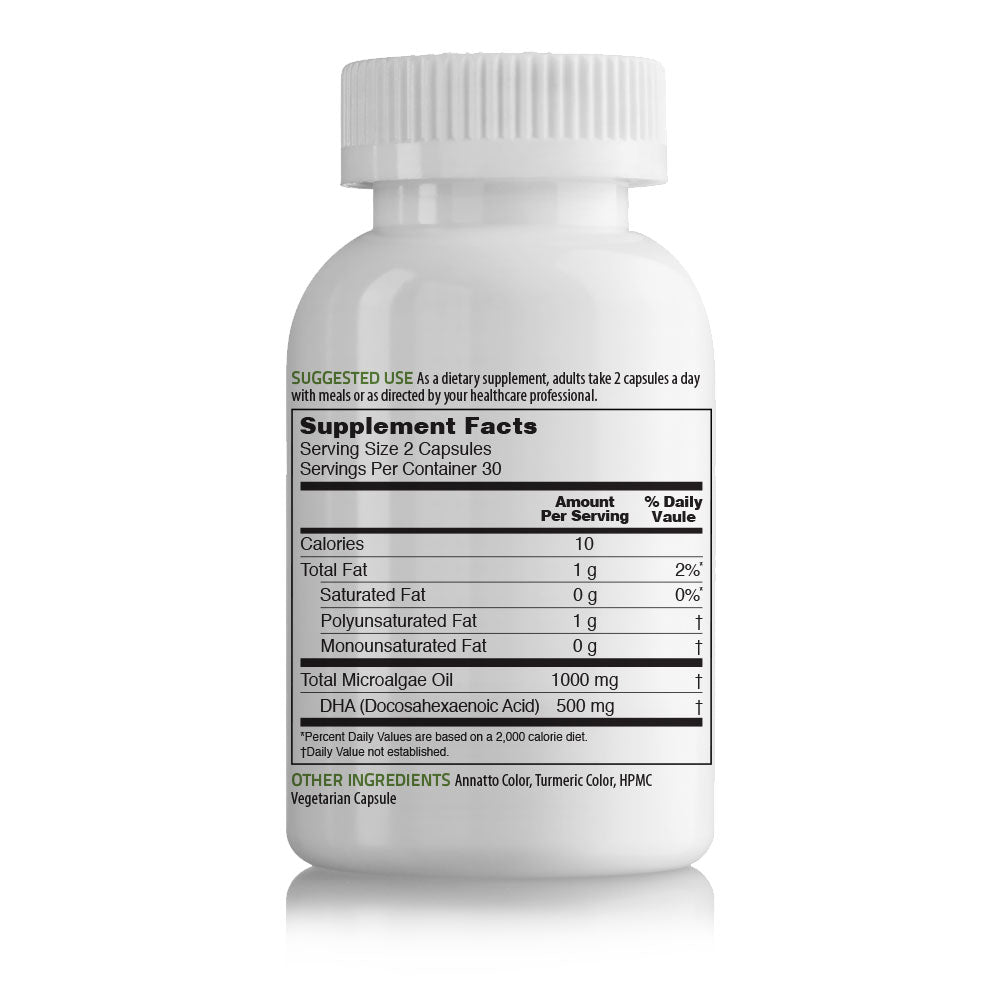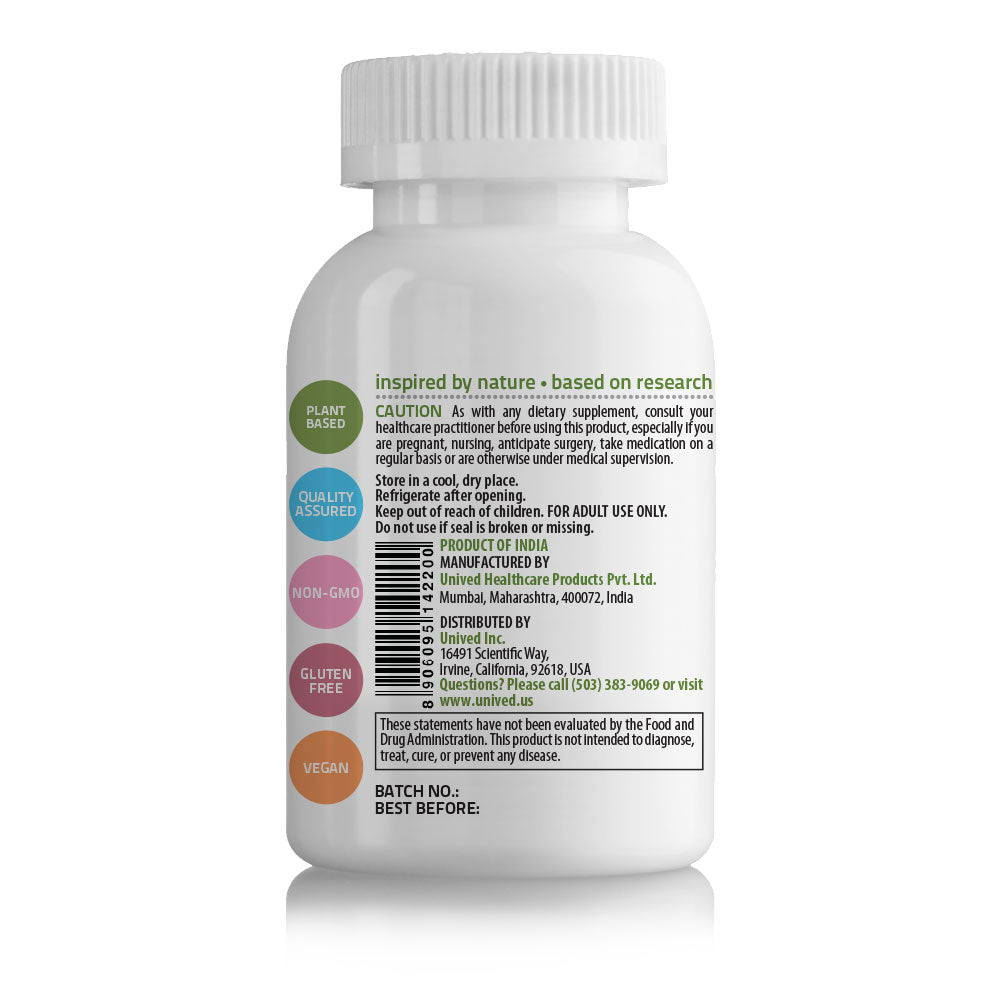Ovegha® DHA
Couldn't load pickup availability
- 500 mg plant-based Omega-3 DHA per serving
- Non-GMO & gluten-free micro-algae
- 60 vegan liquid caps - 1 month supply!
Benjamin Franklin, US author and diplomat once said, "Fish and visitors smell in three days" [Poor Richard's Almanack, 1736]. We're not sure about visitors, but we had the same experience with fish. We never wanted to support their killing, anyway!
OVEGHA offers you pure, unadulterated, non-GMO, natural fermented DHA rich micro-algae oil that is free of ocean borne contaminants and vegan. Each serving of OVEGHA contains 500 mg pure DHA.
OVEGHA is inspired by the lifelong, encompassing nutritional value of DHA through life. Right from the time a baby takes form in the mother's womb to the time an individual grapples with the travails of old age.
OVEGHA IS MORE
More rich
Myth buster: Fish oil vs Micro-algae Most people believe that the richest source of Omega-3 DHA is fish oil. This is a myth. Fish; do not produce Omega-3 DHA. Micro-algae is the world's richest and only primary source of Omega-3 DHA. It is staple food for small marine animals, who in turn are eaten by fish. Algae are the basis for the enrichment of n-3 PUFAs in the lipids of other marine organisms over the aquatic food chain.[3] Most DHA found in the extracted fish oil preparations is derived from micro-algae consumed by the fish.[4] So, fish only get their Omega-3 DHA from the micro algae in their food chain. Why would you want to consume fish oil - when you can benefit from a primary and vegan source - micro-algae?
More sustainable
Two-thirds of our fisheries have depleted. Our oceans are in a crisis. Due to the demand for fish in the food industry and fish oil in the health industry, large populations of fish are being rapidly wiped out of the ocean. This is not a sustainable option. In 2003, the World's large predatory fish populations were estimated to have declined by 90% since the 1950s.[5] We are in 2014! We need to leave the fish where they should be – our ocean. Apart from experiencing the unpleasant taste, smell, fishy burps, you may also be subject to lead, PCBs, toxins, dioxin, mercury, arsenic, and other impurities that fish oil may contain. OVEGHA is made from micro-algae that is fermented in controlled conditions, free of ocean borne contaminants, and non-GMO.
More DHA: Therapeutic dosages
There are many Omega-3 DHA products in the market. Simply consuming Omega-3 DHA is not enough; one must ensure that the correct amount is consumed from the correct source. Omega-3 DHA derived from micro-algae is the correct source as it is the primary source, and is pure, vegan, and free of ocean borne contaminants as the algae is fermented in controlled conditions. Two capsules of OVEGHA deliver 500 mg pure DHA – an adequate dose for adults.[2]
WHAT IS OMEGA 3
Omega-3 is a healthy fatty acid. The three major Omega-3 fatty acids are Alpha-linolenic Acid (ALA), Eicosapentaenoic Acid (EPA), and Docosahexaenoic Acid (DHA). Adequate supplementation of Omega-3 DHA has innumerable health benefits. The insistence about this nutrient prevails among health authorities around the world, including the US FDA. A voluminous quantum of research conducted over the last thirty years has expressed beyond doubt, the importance of dietary Omega-3 fatty acids for healthy heart, eye and brain function. However, the decreasing consumption of this nutrient as a result of modern dietary preferences spells out an irony. Furthermore, the task of reversing this negative dietary trend has been made more difficult in recent months by public concern about fish as a possible source of toxins.
Omega-3 and Omega-6: The right ratio
You need to consume the right kind of fats in the right proportion. The modern diet is replete in saturated fats which spoil the balance of your system and leave several ailments by your bedside. The unsaturated fats on the other hand contribute to your health and enhance it. Polyunsaturated fatty acids (PUFAs) are the need of the hour and more particularly, we need them in an appropriate ratio. The presence of polyunsaturated Omega-3 and Omega-6 fatty acids in your body is vital to achieving optimum health and nutrition. Omega-6 fatty acids are easily available since most junk food is loaded with Omega-6 fatty acids along with trans fatty acids. "Much evidence supports the conclusion that an increased intake of linoleic acid and an elevated ratio of Omega-6 to Omega-3 fatty acids is a major risk factor for western-type cancers, thrombotic diseases, apoplexy, allergic hyperactivity, and diseases for which anti-inflammatory drugs are effective. The World Health Organization and others are now recommending a ratio of between 3:1 and 4:1 for Omega-6 to Omega-3 fatty acids.''[9]
ALA EPA DHA
The essential Omega-3 fatty acids include ALA (Alpha-linolenic Acid), EPA (Eicosapentaenoic acid) and DHA (Docosahexaenoic Acid). ALA, a short-chain Omega-3 fatty acid is found in walnuts, flax-seeds, hemp, soybeans and vegetable oils.
FAQs
What are essential fatty acids?
A low fat or fat free diet isn't essentially a good diet. Your body needs fats for smooth functioning just as it needs carbohydrates and proteins for energy and strength. What matters is the type of fat we allow into the system. The bad – the trans and saturated fats – they increase your body's susceptibility to disease. The good fats include monounsaturated and fats contribute several benefits for healthy dynamics of the body. The two main types of PUFA (polyunsaturated fatty acids) include Omega-3 and Omega-6 fatty acids. These essential fatty acids must be present in your body in the right ratio. They cannot be synthesized by the body hence they need to be acquired through your diet.
What is omega-3?
Omega-3 is a group of polyunsaturated fatty acids which are essential as nutrients for the body. They include ALA (Alpha-linolenic Acid), EPA (Eicosapentaenoic Acid) and DHA (Docosahexaenoic Acid). As these cannot be made by the body, we must acquire them from our diet. Foods such as sunflower, hemp, flaxseed, walnuts and vegetable oils and green leafy vegetables have Omega-3. These sources provide us mostly with ALA. ALA is the short chain parent Omega-3 fatty acid, which is converted to EPA and further converted to DHA – a long chain fatty acid. However this conversion is not very efficient and a very low percentage of ALA is converted to EPA and DHA. This is far lesser than your body's requirement for this nutrition. Since DHA is the most important fatty acid it is beneficial in many ways throughout life, supplements make a difference in physiological and mental health. DHA supports the functioning and development of the brain, heart and eyes.
Why do I need Omega-3 DHA?
DHA is the most important PUFA supporting the function and development of the brain and eyes. It is also plays a major protective role in cardiovascular health.Brain: DHA is of near absolute necessity for the development of the sensory, perceptual, cognitive and motor neural systems. It enables the optimum functioning of the nervous system by improving the messaging of signals between neurons in the brain.
Heart: DHA has been credited with being a key component of the heart, especially in the conducting tissue. It helps maintain normal triglyceride levels, heart rate, and blood pressure.
Eyes: DHA comprises 93% of Omega-3 in the retina. It plays an important role in visual development and visual function throughout life. DHA also has positive effect on conditions such as hypertension, arthritis, atherosclerosis, depression, adult -onset diabetes mellitus, myocardial infarction, thrombosis and some cancers.
How is OVEGHA different from fish oil supplements?
OVEGHA contains algal oil derived from micro-algae which are the most primary and direct source of DHA. OVEGHA thus offers DHA derived from a more direct source which is fermented under controlled conditions. The oily fish get their DHA from the smaller fish and other marine creatures which feed on DHA. They do not synthesize their own DHA but in fact get it from their food chain. Moreover the fish often contain sea borne contaminants which have to be purified in order to make them safe for consumption.
Why can't I get my omega-3 DHA from flaxseeds or walnuts?
It is true that flaxseed, hemp, walnuts, green vegetables, soy or chia seeds etc. are all incredibly nutritious and rich sources of omega-3 fatty acids. However the concern with these sources is that only contain ALA. This ALA is then required to be converted to EPA and DHA. This conversion however is inefficient and a very low percentage of ALA gets converted to DHA. In fact research indicates that the conversion rate is 1% in infants and in adults it is much lower.
What foods contain Omega-3?
Omega-3 can be found in flax, hemp, chia, walnuts, and greens. Oily fish are also a popular source. However, not all fish are a source of DHA. Only certain species of oily fish such as salmon, mackerel, herring, trout, sardines and pilchards etc. procure DHA from the small marine creatures they feed on who in turn consume DHA rich algae. The problem with the above vegetarian sources is that they contain ALA and its conversion to DHA is very low. And though the fish contain DHA, they can be risky for consumption due to presence of contaminants such as heavy metal, methyl, mercury and PCBs. Also, the oceans are suffering from depleting levels of the fish as a result of the demand for them as food and as source of fish oil.
References
1. DHA Supports Brain Development and Protects Neurological Function, By Russell L. Blaylock, MD: Parents should ensure that their young children consume at least 150 mg of DHA per day to support health.2. DHA Supports Brain Development and Protects Neurological Function, By Russell L. Blaylock, MD: Healthy adults should consume 240-1,000 mg of DHA daily to protect their cognitive and neurological health.
3. Lena Burri, Nils Hoem et.al., Marine Omega-3 Phospholipids: Metabolism and Biological Activities, International Journal of Molecular Sciences, 2012.
4. Docosahexaenoic Acid (DHA, Alternative Medicine Review, Volume 14, Number 4, 2009).
5. Myers RA, Worm B: Rapid worldwide depletion of predatory fish communities. Nature 2003; 423:280-283.
6. DHA Supports Brain Development and Protects Neurological Function, By Russell L. Blaylock, MD: 'Pregnant and lactating women require a minimum of 300 mg DHA daily to promote optimal nervous system development in their children.'
7. Catherine Calzada et al., Subgram daily supplementation with docosahexaenoic acid protects low-density lipoproteins from oxidation in healthy men.
8. Meherban Singh, Essential Fatty Acids, DHA and Human Brain.
9. Lloyd Horroks and Young K Yeo, Health Benefits of DHA, Pharmacological Research, Vol. 40, No. 3, 1999.

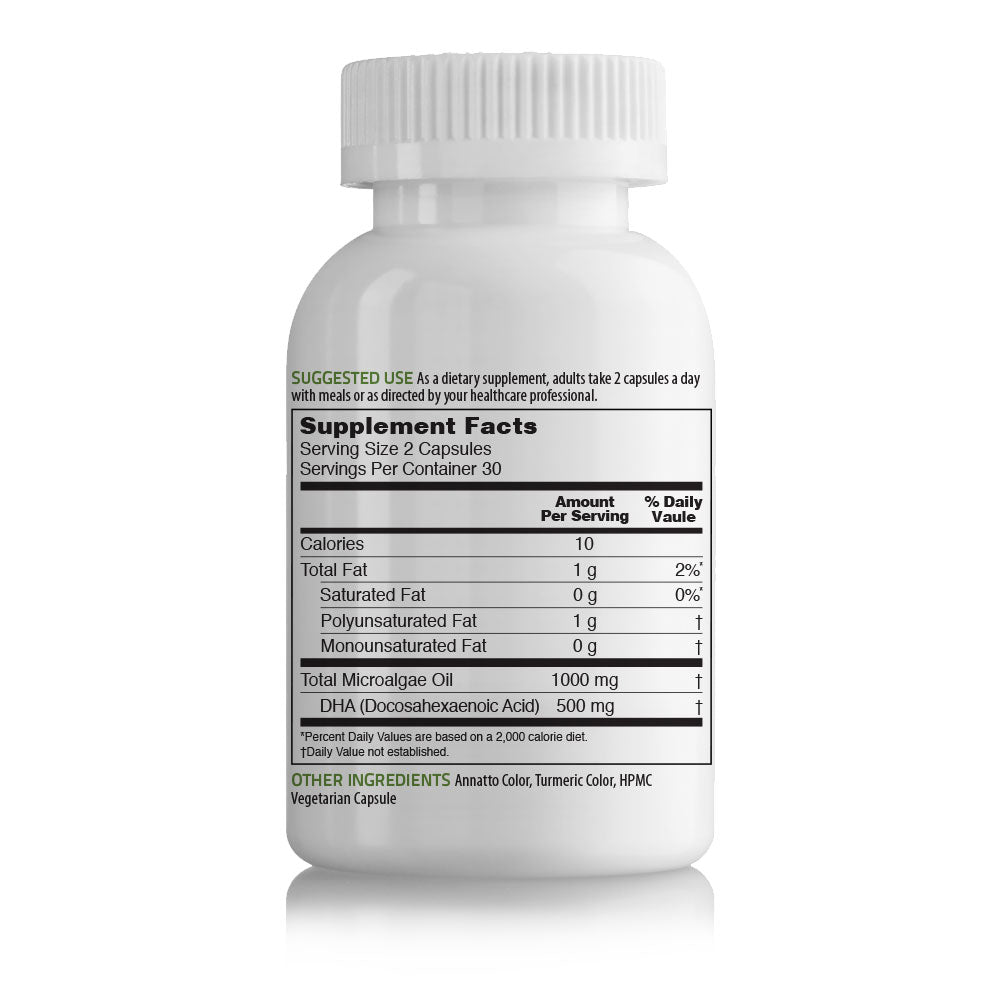
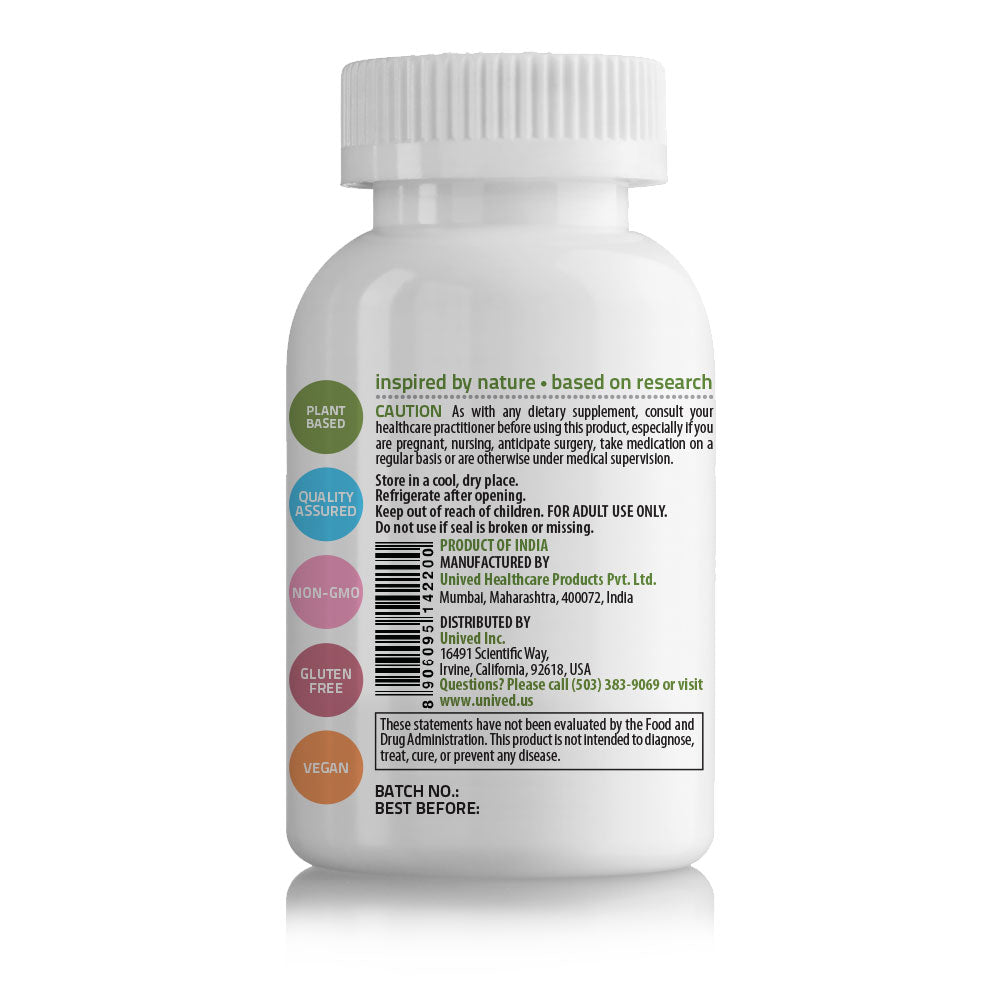

Collapsible content
Ingredients
How To Use

